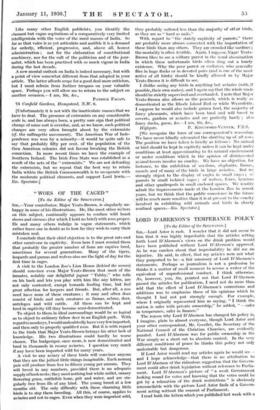" WOES OF THE CAGED " [To the Editor of
the SPECTATOR.]
Sia,—Your contributor, Major Yeats-Brown, is singularly un- happy in some of his illustrations. He, like most other writers on this subject, continually appears to confuse wild beast shows and circuses (for which I hold no brief) with zoos proper. He and many others indulge in vague statements, which rather leave one in doubt as to how far they wish to carry their mistaken zeal.
I conclude that their chief objection is to the great cats and other carnivore; in captivity. Even here I must remind them that probably the greater number of lions are captive bred, sometimes for several generations. Many of the tigers, leopards and pumas and wolves also see the light of day for the first time in cages.
A visit to the London Zoo's Lion House (behind the scenes)
should convince even Major Yeats-Brown that most of the inmates, notably our delightful jaguar " Tubby," who rolls on his back and lets you play with him like any kitten, are not only contented, except towards feeding time, but feel great affection for keepers and friends. But, after all, a zoo need have none of these creatures ; it may and often does .consist of birds and such creatures as llamas, zebras, deer, antelopes and wild cattle. All these can be kept and -bred in captivity till they become semi-domesticated.
To object to them in ideal surroundings would be as logical as to object to ordinary fallow deer in an English park. With regard to monkeys, I would undoubtedly have very few imported, and then only to properly qualified zoos. But it is with regard to the birds that Major Yeats-Brown betrays his utter lack of knowledge. His two illustrations could hardly be worse chosen. The budgerigar, once more, is now domesticated and bred in thousands in roomy aviaries. I question very much if any have been imported wild for many years.
A visit to any aviary of these birds will convince anyone that they are the jolliest little things imaginable. Each normal pair will produce from five to fifteen young per annum. They will breed in any numbers, provided there is an adequate supply of husk nests ; they need nothing but white millet, canary flowering grass, cuttlefish bone, grit and water, and are sin- gularly free from ills of any kind. The young breed at a few months old. The only difficulty with these, charming little birds is to stop.them breeding. All this, of course, applies to aviaries and not to cages. Even when they were imported wild, they probably suffered less than the majority of other birds, as they are as " hard as nails."
With regard to "the stately captivity of parrots," there are probably more abuses connected with the importation of these birds than any others. They are crowded like sardines ; the mortality is often terrible. Again, I suppose, Maio? Yeats- Brown likes to see a solitary parrot in the usual abomination in which these unfortunate birds often drag out a lonely existence. Why the poor parrot or cockatoo, who generally flies in huge flocks or in devoted pairs (and is one of the most active of all birds) should be kindly allowed us by Major Yeats-Brown it is difficult to see.
I dislike seeing any birds in anything but aviaries (with, if possible, their own mates), and I again say that the whole trade should be strictly supervised and overhauled. I note that Major YeatS-Brown also allows us the peacock, which is really as domesticated as the Rhode Island Red or white Wyandotte. -I suppose he would also include guinea fowl, the majority of fancy pheasants; which have been bred and will - breed in coverts, gardens or aviaries and are perfectly hardy ; also fancy ducks, geese, &c.—I am, Sir, &e., [We recognize the force of our correspondent's reasoning. We have never blindly advocated the shutting Up of all zoo;. The position we have taken is briefly as follows : No animal or bird should be kept in captivity unless it can be kept under conditions at least approximating to its natural environment or under conditions which in the opinion of disinterested animal-lovers involve no cruelty. We hace no objection, for instance, to the exhibition of sea-lions, elephants, llamas, camels and of many of the birds in large aviaries. But we strongly object to the display of eagles in small cages ; or parrots in small isolated cages ; of wolves, foxes, hyaenas and other quadrupeds in small enclosed spaces. We readily admit the improvements made at the London Zoo in recent years, but we think that the public conscience in the future will be much more sensitive than it is at present to the cruelty involved in exhibiting wild animals and birds in closely confined spaces.—En. Spectator.]






































 Previous page
Previous page